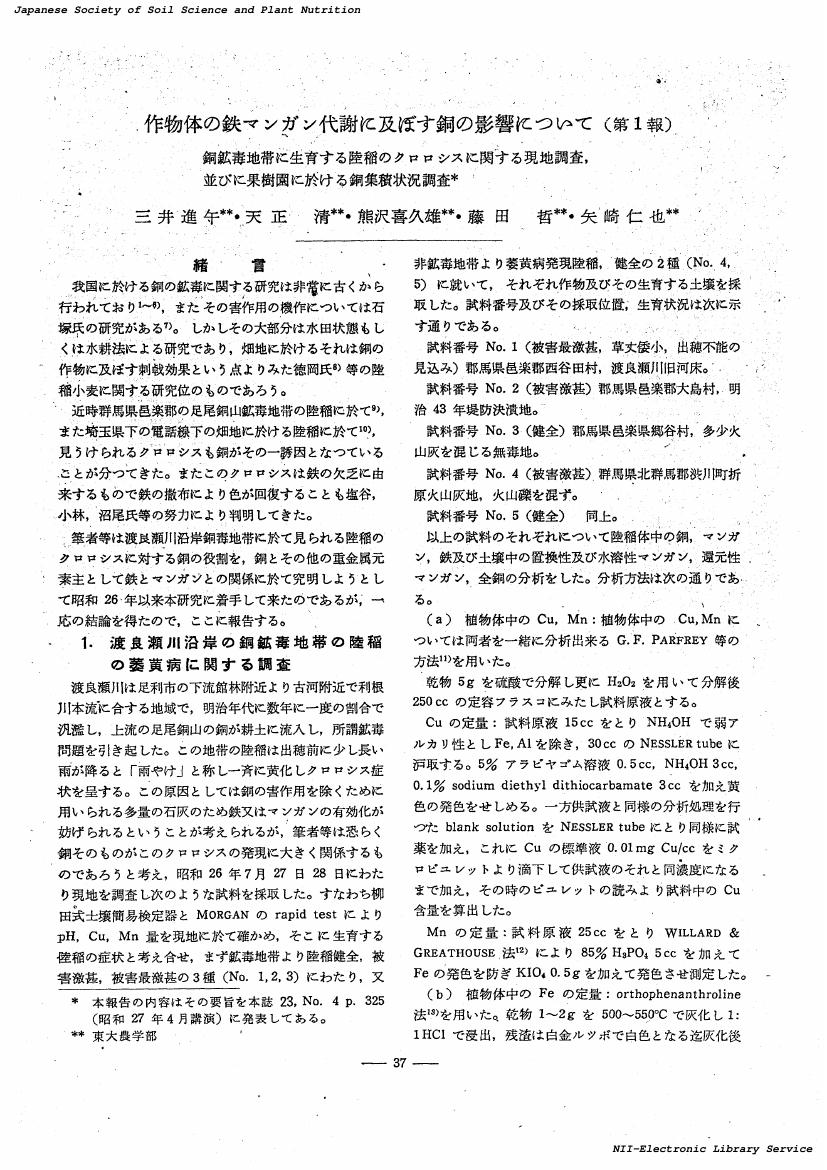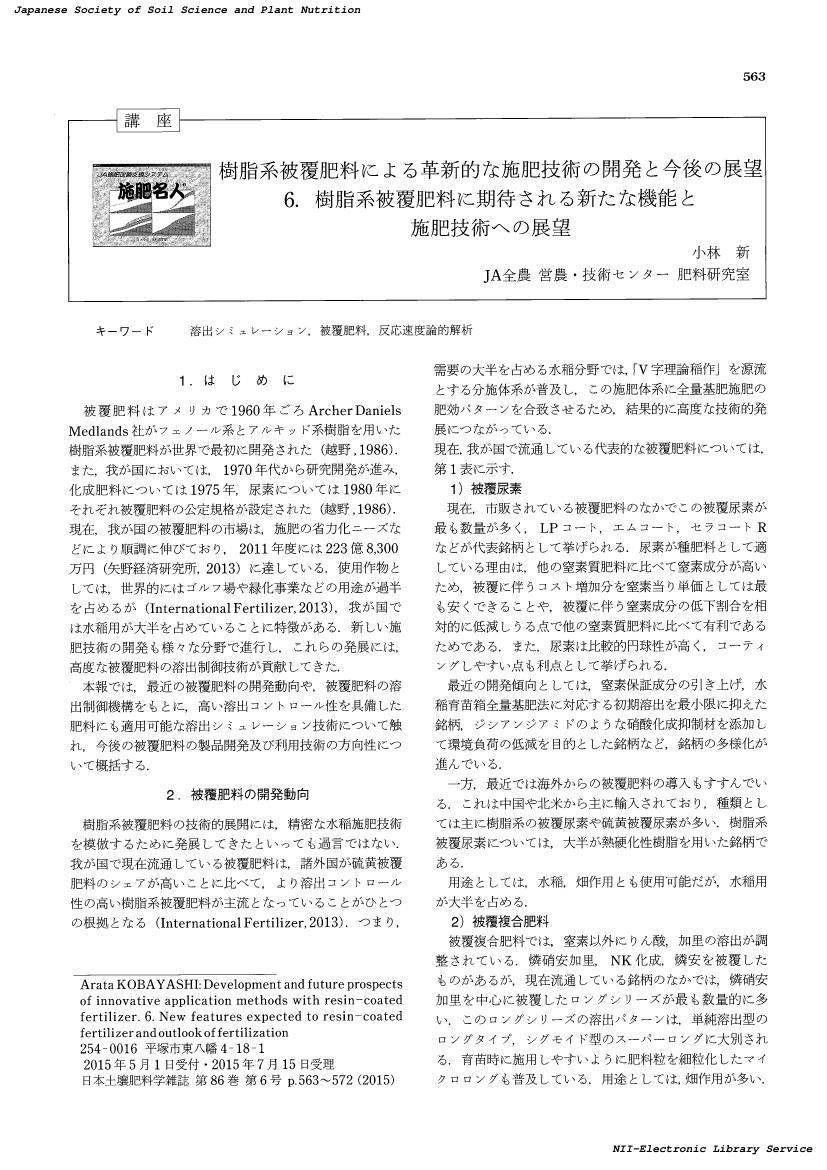- 著者
- 近藤 錬三 佐瀬 隆 相馬 靖
- 出版者
- 一般社団法人 日本土壌肥料学会
- 雑誌
- 日本土壌肥料学会講演要旨集 (ISSN:02885840)
- 巻号頁・発行日
- vol.29, 1983
- 被引用文献数
- 1
1 0 0 0 OA 有機質肥料と有効微生物利用による微生物資材の開発(日本土壌肥料学会技術賞受賞)
- 著者
- 野口 勝憲
- 出版者
- 一般社団法人 日本土壌肥料学会
- 雑誌
- 日本土壌肥料学雑誌 (ISSN:00290610)
- 巻号頁・発行日
- vol.74, no.5, pp.593-596, 2003-10-05 (Released:2017-06-28)
1 0 0 0 OA 根系の発達に及ぼす土壌溶液のアルミニウム種の影響
- 著者
- 加藤 秀正 平井 英明 星野 幸一 松川 進
- 出版者
- 一般社団法人 日本土壌肥料学会
- 雑誌
- 日本土壌肥料学雑誌 (ISSN:00290610)
- 巻号頁・発行日
- vol.76, no.1, pp.1-8, 2005-02-05 (Released:2017-06-28)
- 参考文献数
- 23
- 被引用文献数
- 3
土壌溶液のアルミニウム種とその濃度が植物の根圏環境の形成にどのような影響を及ぼすかを調べ,以下の結果を得た。1)土壌溶液におけるAl^<3+>主成分域のpHとpAlt'はいずれもほぼ4.5以下であった。2)Al_6(OH)_<15>^<3+>主成分域はpHが4.5〜6を示す土壌溶液のAlt'高濃度側に分布した。3)Al_6(OH)_<15>^<3+>主成分域pHにおけるAlt'低濃度側には単独で50%を上回るアルミニウム種が存在しない領域が存在した。4)Al(OH)_2^+主成分域はpHが5以上で,かつpAlt'が5.5付近以上に存在すると予想された。5)水耕と異なり土耕では根系の観察が困難であることから,幼植物の根が把握した土壌量が根系の発達程度の良好な指標となる可能性を示した。6)コムギの根による土壌の把握量が制限されるのは第1にAl^<3+>主成分域であり,次がAl_6(OH)_<15>^<3+>主成分域のうち,土壌溶液のpHが4.5〜5.5付近で,かつAlt'が4〜5とみなされた。7)Al_6(OH)_<15>^<3+>主成分域であっても,pHが5.5付近以上では根の土壌把握量への影響は小さい。これはAlt'値が10^<-5>mol L^<-1>(0.27mg L^<-1>)以下になるためであろう。8)土壌溶液の酸性アルミニウムが中和されるに伴い,根の伸長→根毛の発達・拡大→根による土壌把握量の増大へと進み,根圏における根と土壌間に連続性が保たれる結果,養水分の移動・拡散に好都合な環境が整っていくものと判断された。
1 0 0 0 OA 土の分散・凝集
- 著者
- 喜田 大三
- 出版者
- 一般社団法人 日本土壌肥料学会
- 雑誌
- 日本土壌肥料学雑誌 (ISSN:00290610)
- 巻号頁・発行日
- vol.33, no.8, pp.397-404, 1962-08-05 (Released:2017-06-28)
1 0 0 0 近年の農業へのケイ酸利用と研究 : 連載開始にあたって
- 著者
- 藤井 弘志
- 出版者
- 一般社団法人 日本土壌肥料学会
- 雑誌
- 日本土壌肥料学雑誌 (ISSN:00290610)
- 巻号頁・発行日
- vol.83, no.3, pp.315-318, 2012
- 参考文献数
- 54
- 著者
- 藤井 弘志
- 出版者
- 一般社団法人 日本土壌肥料学会
- 雑誌
- 日本土壌肥料学会講演要旨集 63 (ISSN:02885840)
- 巻号頁・発行日
- pp.234, 2017 (Released:2018-05-28)
1 0 0 0 オーバーヘッドプロジェクター(OHP)を使っての発表の基本
- 著者
- 渡辺 巖
- 出版者
- 一般社団法人 日本土壌肥料学会
- 雑誌
- 日本土壌肥料学雑誌 (ISSN:00290610)
- 巻号頁・発行日
- vol.68, no.6, pp.716-719, 1997
- 参考文献数
- 3
1 0 0 0 OA 日本の農耕地土壌のカリウムの形態 : 地域・圃場・根域スケールでの評価
- 著者
- 森塚 直樹
- 出版者
- 一般社団法人 日本土壌肥料学会
- 雑誌
- 日本土壌肥料学雑誌 (ISSN:00290610)
- 巻号頁・発行日
- vol.80, no.1, pp.80-88, 2009-02-05 (Released:2017-06-28)
- 参考文献数
- 51
- 被引用文献数
- 6
- 著者
- 三井 進午 天正 清 熊沢 喜久雄 藤田 哲 矢崎 仁也
- 出版者
- 一般社団法人 日本土壌肥料学会
- 雑誌
- 日本土壌肥料学雑誌 (ISSN:00290610)
- 巻号頁・発行日
- vol.28, no.12, pp.505-507, 1958-03-05 (Released:2017-06-28)
1 0 0 0 OA 赤玉土および各種無機系吸着剤混合赤玉土による海水の脱塩
- 著者
- 浅岡 聡 青野 求
- 出版者
- 一般社団法人 日本土壌肥料学会
- 雑誌
- 日本土壌肥料学雑誌 (ISSN:00290610)
- 巻号頁・発行日
- vol.77, no.1, pp.33-39, 2006-02-05 (Released:2017-06-28)
- 参考文献数
- 31
- 被引用文献数
- 3
The purpose of this study is to investigate utilization of Akadama soil and evaluate its ion removal efficiency for seawater desalination. The chemical composition of the Akadama soil was Al_2O_3 0.334kg kg^<-1>, SiO_2 0.470kg kg^<-1>, Fe_2O_3 15.7kg kg^<-1> by weight. X-ray powder diffraction pattern, electron diffraction pattern and IR spectrum of Akadama soil showed that allophane was the main phase and low crystallinity kaolin was generated from the allophane. The column method was carried out to evaluate seawater desalination efficiency, the best mixture ratio of the Akadama soil (particle size was less than 250μm), aluminum silicate adsorbent, aluminium magnesium adsorbent, and magnesium oxide adsorbent was 3:1:1:1. Removal percentages of Na^+, Mg^<2+>, Ca^<2+>, K^+ and Cl^- from artificial seawater were 87.7, 84.4, 91.1, 97.3 and 90.7%, respectively. In the batch method, where the mixed adsorbent was used for removal of heavy metals from 20mg L^<-1> solution, the removal percentages of Cu^<2+>, Ni^<2+>, Mn^<2+>, Zn^<2+>, Cd^<2+> and Pb^<2+> were higher than 98%. The removal percentage of PO_4, from river water was 100%.
1 0 0 0 泥炭の化学的組成について(承前)
- 著者
- 市村 三郎
- 出版者
- 一般社団法人 日本土壌肥料学会
- 雑誌
- 日本土壌肥料学雑誌 (ISSN:00290610)
- 巻号頁・発行日
- vol.26, no.1, pp.20-24, 1955
Sphagnum, carex middendorffii, Eriophorum and phrogmites peat, found widely in Hokkaido, had moisture 85-95%, while solid part 5-15%. Peat solid contains organic matter 88-92%, and mineral matter 8-12%. Organic components of peat were fractionated as follows; torfbitumina, watersoluble substance, hemicellulose, cellulose, and humic acid, the main component peing humic scid. It was considered that the humic acid was a complex substance from the decomposed substance of plant lignin; the compound included nitrogenous substance (main component is protein). This included nitrogenous substance was the decomposed compound of bacteria carcass produced, in the decomposition of peat. Inorganic components of peat were made of substances from the residue of plant, accompanied with soils and volcanic ash. Potassium content in the peat was specially less than that of the original plants. Main component of peat was the compound of humic acid and mineral base, with which water-soluble substance, cellulose and hemicellulose were mixed or compounded. It was found that peat was a substance coated with torfbitumina and this coating lowered its absorbed capacity for potassium. This lawering induced the author to recognized that the some parts of mineral bases, from soil and ash, were combined chemically with the peat. Peat had very strong acidity, because the main component was humic acid of low base status. pH of peat was 3.05-3.69.
- 著者
- 寶示戸 雅之 伊藤 伸彦 佐藤 至 佐藤 衆介 岡田 啓司 鈴木 由美子
- 出版者
- 一般社団法人 日本土壌肥料学会
- 雑誌
- 日本土壌肥料学会講演要旨集 (ISSN:02885840)
- 巻号頁・発行日
- vol.60, 2014
- 著者
- 小林 新
- 出版者
- 一般社団法人 日本土壌肥料学会
- 雑誌
- 日本土壌肥料学雑誌 (ISSN:00290610)
- 巻号頁・発行日
- vol.86, no.6, pp.563-572, 2015-12-05 (Released:2017-06-28)
1 0 0 0 OA 圃場条件における緑肥および有機質肥料からの塩基類の溶出
- 著者
- 後藤 忍 江口 洋
- 出版者
- 一般社団法人 日本土壌肥料学会
- 雑誌
- 日本土壌肥料学雑誌 (ISSN:00290610)
- 巻号頁・発行日
- vol.68, no.6, pp.640-644, 1997-12-05 (Released:2017-06-28)
- 参考文献数
- 9
- 被引用文献数
- 5
The release rates of Ca, Mg and K from six green manure (clotararia, pigeon pea, sesbania, guinia grass, sorghum and oats) and three composts prepared from poultry manure, cattle feces and sugar-cane leaves were measured. Green manure and composts wrapped in glass-fiber filter paper were placed in Ap horizon of a Dark Red soil and analyzed for Ca, Mg and K after 1, 3, 6 and 12 months. In addition, the chemical forms of Ca, Mg and K in the original organic materials were characterized by successive extraction with water, 1 tool L^<-1> NaCl, 2% acetic acid and 0.6 mol L^<-1>HCl. For all the materials, more than 90% of K and Mg was water soluble and water plus 1 mol L^<-1> NaCl soluble, respectively, whereas the water-soluble fraction was variable for Ca, ranging from 4 to 68%. The release rate followed the order of K>Mg>Ca for all the materials, reflecting the proportion of water-soluble fraction. For three bases, the release rate was higher for the green manure than for the composts. The amount of K released from the materials in the first 1 month was highly correlated with the water-soluble K, giving the regression of y=1.04χ-0.04 (r=0.99^<**>), where χ and y stand for the amounts of water-soluble K and released K, respectively. Similar relations with lower correlation coefficients were found for Mg, y=1.02χ+0.03 (r=0.84^<**>), and Ca, y-0.67χ+0.08 (r=0.78^*).
- 著者
- 薮谷 充孝 矢内 純太 小崎 隆
- 出版者
- 一般社団法人 日本土壌肥料学会
- 雑誌
- 日本土壌肥料学会講演要旨集 45 (ISSN:02885840)
- 巻号頁・発行日
- pp.430, 1999-07-25 (Released:2017-06-27)
- 著者
- 弘法 健三 大羽 裕 大石 啓子
- 出版者
- 一般社団法人 日本土壌肥料学会
- 雑誌
- 日本土壌肥料学雑誌 (ISSN:00290610)
- 巻号頁・発行日
- vol.45, no.1, pp.8-11, 1974-01-25 (Released:2017-06-28)
- 被引用文献数
- 1
1 0 0 0 OA 豊橋市近郊の石灰岩に由来する土壌における腐植化過程(第2報)
- 著者
- 熊田 恭一 太田 信婦
- 出版者
- 一般社団法人 日本土壌肥料学会
- 雑誌
- 日本土壌肥料学雑誌 (ISSN:00290610)
- 巻号頁・発行日
- vol.36, no.3, pp.57-62, 1965-03-05 (Released:2017-06-28)
- 被引用文献数
- 7
- 著者
- 宮内 菜奈子 柳 参奎 高野 哲夫 中西 啓仁
- 出版者
- 一般社団法人 日本土壌肥料学会
- 雑誌
- 日本土壌肥料学会講演要旨集 62 (ISSN:02885840)
- 巻号頁・発行日
- pp.59, 2016-09-20 (Released:2017-12-02)
- 著者
- 三枝 正彦
- 出版者
- 一般社団法人 日本土壌肥料学会
- 雑誌
- 日本土壌肥料学雑誌
- 巻号頁・発行日
- vol.86, no.5, pp.487-488, 2015
- 著者
- 落合 久美子
- 出版者
- 一般社団法人 日本土壌肥料学会
- 雑誌
- 日本土壌肥料学雑誌 (ISSN:00290610)
- 巻号頁・発行日
- vol.86, no.4, pp.319-323, 2015









